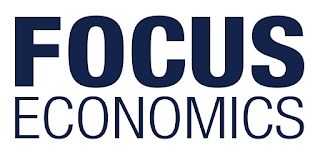Comprehensive GDP data revealed that the recovery lost steam in the fourth quarter of last year, with growth weighed on by inventories as well as slowing fixed investment. Recent indicators, however, suggest that activity likely bounced back in the first quarter of 2018 and that overall the recovery remains on track if lackluster. Consumer confidence improved in Q1 and the unemployment rate inched down in February, boding well for household spending in the quarter. Positive signs emerged from the external sector as well with exports growth hitting a 10-month high in January and the Ural oil price jumping in March, which should support export revenues. On the political front, as widely expected, President Vladimir Putin won the 18 March election, securing over 75% of the votes. More recently, on 6 April, the United States unveiled new sanctions against several high-profile Russian businessmen and their affiliated companies. The measures freeze their U.S. assets and ban Americans from conducting business with them. The sanctions caused turmoil in Russian financial markets, with the main stock index diving and the ruble depreciating over 4.0% on 9 April.
Rising oil prices, a healthy labor market and improved consumer confidence should cause growth to gather steam this year. However, limited oil output and structural rigidities will hamper activity, while the impact of the fresh sanctions is still uncertain. Focus Economics Consensus Forecast panelists see GDP expanding 1.8% in 2018, which is unchanged from last month’s forecast. In 2019, growth is seen stable at 1.8%.
source: tradingeconomics.com
The consumer confidence indicator published by the Federal Statistics Service (Rosstat) improved in Q1 2018, rising to the highest reading since Q3 2014. The consumer confidence indicator rose from Q4 2017’s minus 11 points to minus 8 points. Despite the rise, the index remains firmly entrenched below the 0-threshold, which indicates that pessimists outnumber optimists. According to the survey, the improvement was broad-based across the components of the index. Households were more optimistic about the future economic situation in Russia and assessed the current situation less negatively than in the previous quarter. In addition, households’ assessments of their current and future personal financial situation improved in Q1. FocusEconomics Consensus Forecast panelists expect private consumption to expand 3.3% in 2018, which is up 0.3 percentage points from last month’s projection. For 2019, panelists expect private consumption to increase 2.6%
MONEY
Central Bank cuts key interest rate to 7.25% in March At its 23 March meeting, the Board of Directors of the Central Bank of the Russian Federation (CBR) decided to cut the key interest rate by 25 basis points to 7.25%, a move widely expected by market analysts. The decision followed a same-sized cut in February and marks the lowest policy rate since April 2014. Low inflationary pressures have given the Bank space to pursue an easing cycle as it aims to transition to neutral monetary policy. In its accompanying statement, the CBR commented that inflationary expectations are continuing to fall, and that price pressures remain low; they are, however, low partly due to a favorable base effect. The Bank expects inflation to return to its target of 4.0% in the second half of 2018 as this base effect from high food prices last year fades. Notably, it made no changes to its growth projections for the Russian economy this month despite higher oil prices, citing ongoing structural issues and lower sensitivity to oil price fluctuations as the reasons for the unchanged prospects. Looking forward, the Bank signaled that more cuts are in the pipeline, as it stated that it plans to complete the transition to neutral monetary policy by the end of the year. A key interest rate of between 6–7% is considered as roughly neutral. The Bank, however, highlighted one new upside risk to its inflation outlook: A tight labor market could put upward pressure on prices through higher wages. The next monetary policy meeting is scheduled for 27 April 2018. FocusEconomics panelists see the key interest rate ending 2018 at 6.56%. In 2019, panelists see the Central Bank lowering the monetary policy rate further, with a Consensus Forecast of 6.15%.
Central Bank cuts key interest rate to 7.25% in March At its 23 March meeting, the Board of Directors of the Central Bank of the Russian Federation (CBR) decided to cut the key interest rate by 25 basis points to 7.25%, a move widely expected by market analysts. The decision followed a same-sized cut in February and marks the lowest policy rate since April 2014. Low inflationary pressures have given the Bank space to pursue an easing cycle as it aims to transition to neutral monetary policy. In its accompanying statement, the CBR commented that inflationary expectations are continuing to fall, and that price pressures remain low; they are, however, low partly due to a favorable base effect. The Bank expects inflation to return to its target of 4.0% in the second half of 2018 as this base effect from high food prices last year fades. Notably, it made no changes to its growth projections for the Russian economy this month despite higher oil prices, citing ongoing structural issues and lower sensitivity to oil price fluctuations as the reasons for the unchanged prospects. Looking forward, the Bank signaled that more cuts are in the pipeline, as it stated that it plans to complete the transition to neutral monetary policy by the end of the year. A key interest rate of between 6–7% is considered as roughly neutral. The Bank, however, highlighted one new upside risk to its inflation outlook: A tight labor market could put upward pressure on prices through higher wages. The next monetary policy meeting is scheduled for 27 April 2018. FocusEconomics panelists see the key interest rate ending 2018 at 6.56%. In 2019, panelists see the Central Bank lowering the monetary policy rate further, with a Consensus Forecast of 6.15%.
Read More At Focus Economics
Data from: Focus Economics, Zermatt Research, Rosstat, Trading Economics
Read more about Chad Hagan




